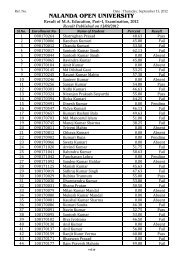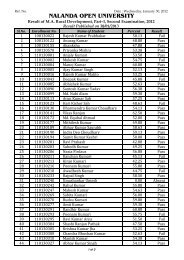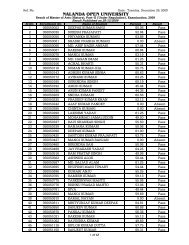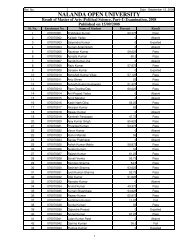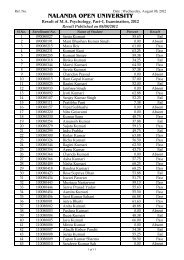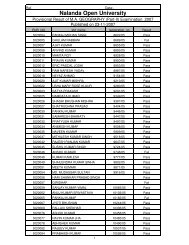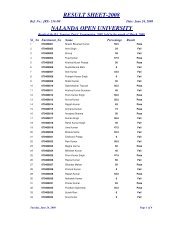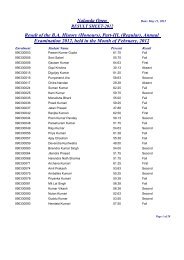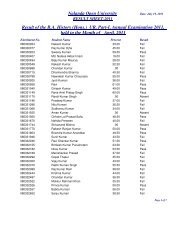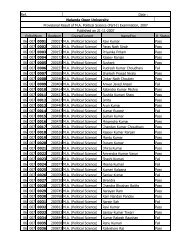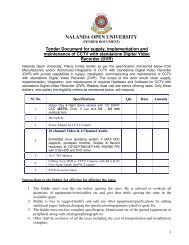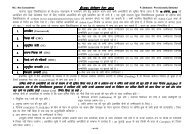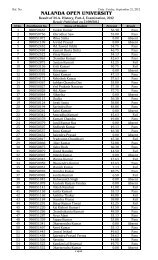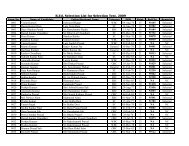M.A. (Education) Part I and II - Nalanda Open University
M.A. (Education) Part I and II - Nalanda Open University
M.A. (Education) Part I and II - Nalanda Open University
You also want an ePaper? Increase the reach of your titles
YUMPU automatically turns print PDFs into web optimized ePapers that Google loves.
NALANDA OPEN UNIVERSITY<br />
M.A. [<strong>Education</strong>]<br />
PART–<strong>II</strong>, PAPER–XVI (Old)<br />
¼<strong>Education</strong>al Evaluation½<br />
Annual Examination, 2012<br />
Time : 3 Hours Full Marks : 80<br />
fdUgha fdUgha fdUgha fdUgha ik¡p ik¡p ik¡p ik¡p iz'uksa iz'uksa iz'uksa iz'uksa ds ds ds ds mÙkj mÙkj mÙkj mÙkj nhft, nhft, nhft, nhft, A A A A lHkh lHkh lHkh lHkh iz'uksa iz'uksa iz'uksa iz'uksa ds ds ds ds vad vad vad vad leku leku leku leku gSa gSa gSa gSa A AA<br />
A<br />
Answer any Five Questions. All questions carry equal marks.<br />
1. Define evaluation <strong>and</strong> explain its need <strong>and</strong> importance in education, with illustrations.<br />
ewY;kadu dks ifjHkkf"kr dhft, rFkk f'k{kk esa mlds egÙo vkSj mldh vko';drk dks mnkgj.k ds<br />
lkFk Li"V dhft, A<br />
2. Explain internal <strong>and</strong> external evaluation <strong>and</strong> discuss advantages <strong>and</strong> disadvantages of<br />
internal evaluation.<br />
vkUrfjd ,oa cká ewY;kadu dh O;k[;k dhft, rFkk vkUrfjd ewY;kadu ds xq.k ,oa nks"kksa dh foospuk<br />
dhft, A<br />
3. Discuss the various approaches of evaluation. Differentiate between Norm referenced<br />
<strong>and</strong> criterion referenced evaluation.<br />
ewY;kadu ds fofHkUu mikxeksa dk o.kZu dhft, A ekud lanÆHkr rFkk ekun.M lanÆHkr ewY;kadu esa<br />
vUrj Li"V dhft, A<br />
4. What is difference between educational <strong>and</strong> instructional objectives. Describe the<br />
Bloom's theory of Instructional objectives.<br />
'kSf{kd ,oa 'kS{kf.kd mís'; esa D;k vUrj gS \ Cywe ds 'kS{kf.kd mís'; fl)kUr dk o.kZu dhft, A<br />
5. Explain essential criteria of a good evaluation tool with examples.<br />
ewY;kadu ds vPNs midj.k dh vko';d dlkSVh dh O;k[;k lksnkgj.k dhft, A<br />
6. What are the various tools of evaluation ? Differentiate between rating scale <strong>and</strong><br />
anecdotal record.<br />
ewY;kadu ds fofHkUu ;a= dkSu&dkSu ls gSa \ fu/kkZj.k ekiuh ;a= rFkk ?kVukØe vfHkys[k esa vUrj Li"V<br />
dhft, A<br />
7. Explain the concept of Question Bank <strong>and</strong> discuss its advantages <strong>and</strong> disadvantages.<br />
iz'u cSad dh vo/kkj.kk dh O;k[;k dhft, rFkk blds ykHk&gkfu;ksa dh foospuk dhft, A<br />
8. Define the term 'Reliability'. Describe three approaches to estimate reliability of an<br />
achievement test.<br />
fo'ouh;rk 'kCn dks ifjHkkf"kr dhft, A miyfC/k ijh{k.k dk fo'oluh;rk dk vkdyu djus ds fy,<br />
fdUgha rhu mikxeksa dk o.kZu dhft, A<br />
9. Describe the concept of Dispersion <strong>and</strong> differentiate between the measures of central<br />
tendency <strong>and</strong> the measures of dispersion.<br />
izdh.kZu dh vo/kkj.kk dk o.kZu dhft, rFkk dsUæh; izo`fÙk dh ekiksa ,oa izdh.kZu ds ekiksa esa vUrj<br />
dhft, A<br />
10. Write short notes on any Two of the following :—<br />
fuEufyf[kr esa ls fdUgha nks nks nks nks ij laf{kIr fVIif.k;k¡ fyf[k, %&<br />
(a) Projective Technique ¼iz{ksih rduhdh½<br />
(b) Validity ¼oS/krk½<br />
(c) Diagnostic Test ¼funkukRed ijh{k.k½<br />
(d) Measurement, Assessment <strong>and</strong> Evaluation ¼ekiu] ewY; fu/kkZj.k ,oa ewY;kadu½



